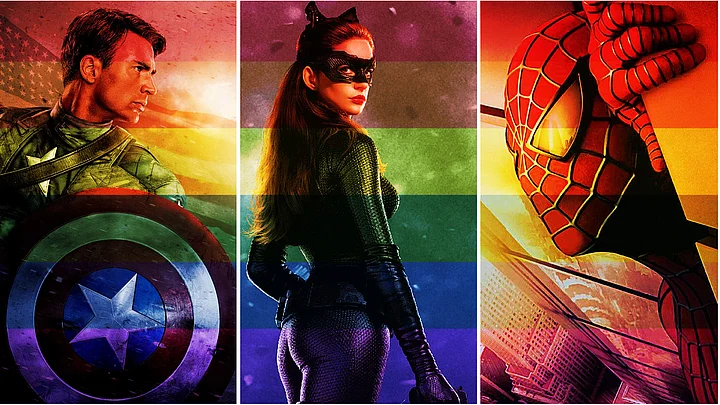Close your eyes for a moment and visualise Superman’s wedding. With a man.
Or imagine watching on the big screen, your ideal hyper-masculine superhero, Captain America, making love to his boyfriend?
If your reaction is of disgust and horror, join the homophobic gang. If not, read on.
When #GiveCaptainAmericaABoyfriend trended on Twitter this May, the world opened its eyes to the possibility of having ‘queer’ representations of the otherwise heterosexual superheroes.
Comic-book narratives of coming out have found a place internationally. But can India begin to lend a satrangi tinge to its comics?
The Narrative Of Coming Out
If you ain’t white, male or straight, you got a problem.
Or that’s what pop culture representations make you believe.
It’s a truth unknown that several superheroes from both the Marvel and DC universes are written as LGBT or with a fluid sexuality.
But when they hit the big screen, they not-so-magically become straight.
Masculanised, whitewashed and hollywood-ified, comic-book superheroes are constructed as perfectly heterosexual, selectively emotional, and definitely heroic. As ideal custodians of superpowers, strength, and masculine agility, they are a modern myth to our subconscious fantasies of being heroes ourselves.
Comic book narratives have been teeming with ideas of secret identities and alter egos, situations of distress and societal expectations, where the superhero emerges as an empowered character.
But heterosexual superheroes seem to have an exclusive claim to this ‘heroism.’ It’s unfortunate, and that exclusion is not benign.
That’s why when Deadpool was announced pansexual by its maker, or when mutant Iceman came out in “Uncanny X-men”, and Batman’s supposed other half, Catwoman, was declared bisexual, the concept of sexual diversity in superheroes/heroines that this generation has grown up idolising, became real.
It became real that outside of long capes and paranormal powers, superheroes can be queer.
These representations also lend a hand towards associating ideals of heroism and strength to people who are queer, which can help challenge their mainstream perceptions.
There have been several path-breaking comic books and graphic novels that have been thwarting the supremacy of heroic strength enjoyed by good ol’ straight men.
Mainstream heroes like Catman who made his first appearance in 1963 in ‘Detective Comics’, was declared bisexual by writer Gail Simone in 2014. X-men’s Northstar isn’t known for his superhuman flying skills alone, but also for being the first openly gay superhero.
In the alternate space, ‘Flutter,’ an indie-graphic series created by Jennie Wood, tells the story of 15-year-old Lily who shape-shifts into a boy to win the heart of the girl.
The series ‘Stripling Warrior,’ written by Brian Andersen, features heroes who are gay, lesbian and Mormon.
In May this year, Shape History, a social change organisation, created a trailer that gives fans the opportunity to see LGBTQ superheroes accurately brought to life.
Has India Caught On To The Trend?
Have Indian comic/graphic novels scratched the surface for a more equal representation of sexual diversity in their narratives?
Sreejita Biswas, graphic artist and comic-book maker based in Bengaluru, does not think so.
India’s history with LGBTQ characters in comics hasn’t been great, much like most of our LGBTQ literature. But Amruta Patil’s Kari featured a queer woman as the protagonist. Gaysi last year came out with The Gaysi Zine – India’s first queer anthology of graphics, comics and doodles. Last year I did a manga which was published in Japan about a queer girl, but that’s about it.Sreejita Biswas, graphic artist
Biswas is also the co-founder of Striptease magazine, an e-venture that writes about graphic novels and comics.
“People are creating comics on issues like homophobia and menstruation which is subversive in its own way but it’s not mainstream. If you talk mainstream, you think Nagraj and that is still mythological.”
While the trend to include characters that challenge hetero-normative portrayals of superheroes is catching up in India, it’s still relegated to alternate, fringe spaces.
Will Captain America Ever Have a Boyfriend?
Is it easier for a catwoman to declare queerness than a Captain America?
With perfectly chiseled bodies being a cultural staple – symbolic of the ideal masculine figure – can audiences reconcile sexual fluidity in their mainstream male superheroes?
“People still want clean, straight-forward narratives about their superheroes. Even directors who are making films out of these comics want to create something that does not stir a social debate,” says Biswas.
Queer representations are still mostly limited to peripheral characters. Maybe in an ethos where masculinity as a concept is fragile and superheroes are worshiped, it will take a while for Captain America to come out.
In an interview to the New York Times, Andrew Wheeler, editor-in-chief of Comics Alliance put it well.
We’ll know we’ve achieved success when Captain America can have a boyfriend, and Wonder Woman can have a girlfriend. For queer representation in superhero comics, that’s what success looks like.
